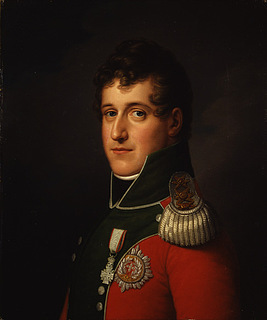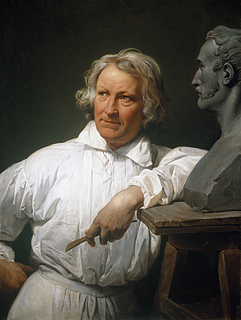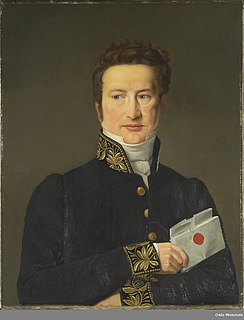Christian 8.'s Loan from Thorvaldsen
- Nanna Kronberg Frederiksen, arkivet.thorvaldsensmuseum.dk, 2014
- Translation by David Possen
By 1821, Thorvaldsen was so well-off that he could afford to lend a large sum of money to the Danish prince Christian (8.) Frederik. However, Christian Frederik subsequently had difficulty repaying the sculptor’s loan. Ultimately, Thorvaldsen generously forgave a portion of the prince’s debt.
A well-kept secret
As far as is known, no previous attempt has been made to describe the events surrounding the large sum of money loaned by Thorvaldsen to the Danish prince Christian (8.) Frederik in 1821, and which the prince subsequently had difficulty repaying. The reason for this silence may be that both the parties to the loan and the others involved shielded the loan with so much discretion—indeed, with such secrecy—that later generations have had difficulty getting a clear view of the matter at all.
Christian Frederik himself omitted any hint of the affair in his otherwise quite detailed diaries and travel entries. Nor did Just Mathias Thiele mention the loan in his biography of Thorvaldsen. This last is noteworthy, as Thiele was otherwise eager to cite letters and describe events that shed light on Thorvaldsen’s relations with high-ranking personages.
That the affair of the loan has now come to light is partly due to the fact that the certificate of indebtedness, along with 27 related letters and drafts, have been published and made searchable in The Thorvaldsens Museum Archives. These 28 documents were exchanged among three people: Thorvaldsen, Christian Frederik, and the latter’s private secretary, Johan Gunder Adler. The narrow circle of initiates indicates that no outsiders were involved; and Thorvaldsen did not gossip, at least not in writing. This allowed the loan to sink to the bottom of history as a well-kept secret—until now.
The loan and its conditions
During Christian Frederik’s grand European tour of Germany, Italy, Switzerland, France, and England in 1818-1822, the prince loaned money from Thorvaldsen, as emerges from the certificate of indebtedness dated 1.4.1821, in the amount of 9000 Roman scudi, with annual interest of 5%, i.e., 450 scudi. The 9000 scudi were equivalent to ca. 238 kg of pure silver.
According to the certificate of indebtedness, Christian Frederik was to pay interest on the loan, but not amortize (regularly pay down) the principal. This was, in other words, a kind of “interest-only loan,” in which the principal was to be paid back in its entirety only after the loan was called in by one of the parties to it.
Interest on the loan was paid biannually eleven times in all, for a total of 2475 scudi, until 9.12.1826, when Thorvaldsen called in the loan and requested that the full amount be made available to him via the Torlonia banking firm. The reason for this—as he related to the prince’s private secretary, Johan Gunder Adler—was that he planned to produce a colossal bronze-cast goddess of victory in a horse-drawn carriage at his own expense, and so needed to liquidify his outstanding assets.
Breach of contract
Despite §1 of the certificate of indebtedness, which affirms that the loan must “unalterably” (“uvægerligt”) be repaid to Thorvaldsen no later than three months after termination of the agreement, Christian Frederik had to balk at paying the full amount on time, as for various reasons he was short of money. Instead, it was suggested via Adler that Thorvaldsen could receive the money gradually. Specifically, the wish was expressed that Thorvaldsen redeem as little as possible of the debt in 1827, and wait with the remainder until 1828 and 1829, by which point it would be “less difficult for the prince” to repay the loan’s principal.
Thorvaldsen did not respond to this breach of contract with anger. Rather, he wrote back to the prince in a friendly—and slightly ironic—tone:
“I thank your Royal Highness most humbly for taking on the burden of administering the sum of money belonging to me. Without a doubt, I could hardly have found a better place to keep it.”
In the continuation of this letter, Thorvaldsen repeated his wish to recover the money, but now offered a deeper explanation. The money was to be used not only for the goddess of victory, but also to pay for the marble carving of his works, as he planned to “leave behind a rather select collection, instead of money.” This is the first time Thorvaldsen formulated his idea of a “Thorvaldsens Museum” in writing, and so the full text must be reproduced here:
“My intention, namely, is to have a monument be cast in bronze depicting the goddess of victory in natural size on a triumphal carriage drawn by two or four horses. Beyond this, I have many other works that I have produced or will produce in marble at my own expense. When I add to this my collection of ancient and modern artworks, which multiply daily, I hope to leave behind a rather select collection, instead of money.”
In other words, the 9000 scudi were to be used to initiate the establishment of Thorvaldsens Museum. It is worthy of note that Thorvaldsen’s conception of the museum and its contents was realized so consistently in the completed museum, which only opened 21 years later. Thorvaldsens Museum contains Thorvaldsen’s own artworks as well as his collections of ancient and modern art, and is crowned by a triumphant goddess of victory in a quadriga, situated on the museum’s roof.
In short, Thorvaldsen had to wait to withdraw the money he needed to kick-start his museum project. He acceded to Adler’s request for a postponement: not only did he withdraw the money a little at a time, but he also waited until 1831 to recover the entire loaned sum. We can only guess whether this was due to special consideration for Christian Frederik and his financial situation—or whether Thorvaldsen’s own plans were delayed for other reasons.
Inscriptions on the certificate of indebtedness indicate that Thorvaldsen withdrew the 9000 scudi from Torlonia gradually and in three steps:
- 2000 scudi on June 26, 1829 (first withdrawal)
- 2000 scudi on October 8, 1829 (second withdrawal)
- 5000 scudi on October 20, 1831 (third withdrawal)
Forgiveness of the Prince’s debt
In a letter dated 12.8.1828, Adler remarked conscientiously that because Thorvaldsen had not yet begun withdrawing his money from Torlonia, he was entitled to two biannual interest payments, which Adler would take care of paying as soon as Thorvaldsen wished.
No response to this by Thorvaldsen is extant today. But on 9.5.1829, Thorvaldsen informed Adler that he would now have to withdraw a portion of the principal—without mentioning with a single word the accumulated interest to which he would have been entitled during the preceding period of time (from December 9, 1826 to May 9, 1829), nor the future interest that would accrue to him on the remainder of the principal. This can be interpreted in a variety of ways. In the next section, several different hypotheses will be offered to explain why Thorvaldsen did not demand the interest payments to which he was entitled from Christian Frederik, but instead chose to forgive the prince that portion of his remaining debt.
Generosity and a power play: possible reasons for Thorvaldsen’s forgiveness of the prince’s debt
All in all, Thorvaldsen forgave Christian Frederik 1800 Roman scudi in interest debt. This corresponds to ca. 47.5 kg of silver, or 1881 rigsdaler / 3762 rigsbankdaler, which were the Danish monetary units in use before and after 1813, respectively.
For a better sense of the size of this sum, it may help to consider that a professor at the Academy of Arts in Copenhagen received an annual salary of 400 rigsdaler in 1805. In 1829, after the Danish state bankruptcy and subsequent deflation, we find that, in the household budget of the newly-married Princess Caroline and Crown Prince Ferdinand, the sum of 17000 rigsbankdaler was set aside as wages for the 55 workers who made up their court staff and servantry. 1800 scudi was thus a sizable sum, corresponding approximately to the annual salaries of four and a half professors or twelve employees of the court. This was the amount Thorvaldsen forfeited by refraining from demanding the final interest payments due to him from Christian Frederik.
What, then, were Thorvaldsen’s reasons for forgiving the debt owed to him?
1) It might be thought that Thorvaldsen was financially unsophisticated, and gave little thought to the lost income. This, however, seems implausible, given the precision and care with which Thorvaldsen otherwise treated the transaction. Judging by the extant correspondence, Thorvaldsen was fully conversant with the certificate of indebtedness, the inscriptions recording interest payments, the dates, the signatures, and the other formalia.
2) Alternatively, Thorvaldsen’s forgiveness of the prince’s remaining debts might be thought to be an expression of the sculptor’s generosity of character. Perhaps it pained Thorvaldsen that the prince was reduced to borrowing money. Perhaps he thought it downright embarrassing that the prince could not repay the loan on time. Perhaps he believed it would add insult to injury to demand “minor interest payments” under such circumstances.
3) Still another possibility is that, by forgiving the remaining debt, Thorvaldsen wished to express his thanks to Christian Frederik for supporting him—both as a private individual and in his capacity as President of the Academy of Fine Arts in Copenhagen—both directly and indirectly, through numerous commissions.
4) Next, Thorvaldsen’s forgiveness of the remaining debt could have been part of a power play: the sculptor might have wished to have a bit of viable “dirt” on Denmark’s monarch-to-be. For by generously and discreetly forgiving the outstanding interest, Thorvaldsen put the prince into a debt of gratitude as well as money. And what might Thorvaldsen have achieved by doing so? Perhaps it suited Thorvaldsen, who was working to make his museum in Denmark a reality, that Christian Frederik thereby gained special motivation to support his cause before the king, whose approval of the museum project was necessary. The money held up by Christian was “museum money,” after all.
5) Finally, Thorvaldsen’s forgiveness of the remaining debt could have been an artifact of his liberal political stance. Christian Frederik departed a land suffering from stagnation and strong deflation, and embarked on a long, expensive journey with his young wife and son, along with a large following of attendants and ladies of the court. He made grand purchases of art, gifts, and things for the home, but the large loan he took out from Thorvaldsen, and his delay in repaying it, attest to a prince who was living beyond his means. Perhaps it amused Thorvaldsen, in the quiet of his own mind, to see a prince bedecked in borrowed feathers. Both by extending the loan at first, and later by partly forgiving it, Thorvaldsen revealed—both subtly and unimpeachably—that the absolute monarchy’s basis (at least its financial basis) lay not in God, but in a perfectly ordinary man—namely, Thorvaldsen himself.
A liberal supports a conservative partisan of the Unitary State
It turns out that Christian Frederik’s debt to Thorvaldsen was only a small portion of a larger financial morass. The Danish historian Marcus Rubin, who was also director of Denmark’s national bank, made a study of “the royal family’s extraordinary consumption” and described how the state treasury had to disburse large additional sums to Christian Frederik in order to fill gaps in his finances. Rubin writes:
“Even stranger were the additional sums disbursed. In 1822, Prince Christian Frederik received in part £3,000 to travel to England, and in part 130,000 Rbdl. [Rigsbankdaler] to cover a debt that had arisen as a result of poor management of his royal household. In 1831, the Finances had to cover a new debt on his behalf of 100,000 mk. banco to Donner, and loan him 20,000 Rbdl. in addition. On that occasion, however, the king ordered Møsting to confer with the prince’s cabinet secretary, state councillor Adler, about means to prevent such things in the future, ‘as our finances will not then be in a position to cover such extraordinary expenses.’”
Christian Frederik’s own diaries and notes reveal that, in 1826, he had incurred an additional debt of 141,000 marks banco to the Danish bank director and merchant Conrad Hinrich Donner, who is mentioned in the above citation. This debt was also assumed by the state treasury, though Christian Frederik was obliged to make annual amortization payments.
These various debts and obligations, resulting from the fact that Christian Frederik lived an aristocratic lifestyle beyond his means, were also the reason why he could not immediately repay the 9000 scudi when Thorvaldsen requested them in 1826.
Both Thorvaldsen’s loan to Christian Frederik and his partial forgiveness of it were high-minded gestures. It must have been a humiliating affair for Christian Frederik to receive “charity” from a man who had achieved total financial freedom by his own industriousness. In that sense, the episode of the loan was also a political affair, though the extent to which Thorvaldsen was aware of this has not been documented. Namely: Christian Frederik, a conservative partisan of the Unitary State, was financially supported for a decade by a liberal- and high-minded artist, and the hierarchical relations of power between prince and subject were reversed. In this sense, Thorvaldsen contributed indirectly to the emergence of cracks in Denmark’s absolute monarchy—a system that he certainly did not join, but which he never criticized openly. This is one of the many ways in which the affair of the loan is both paradoxical and fascinating.
References
- Documents related to the topic Christian 8.’s Loan at Interest.
- Albert Fabritius, Finn Friis & Else Kornerup (ed.): Kong Christian VIII.s dagbøger og optegnelser, 1815-1821, vol. II, tome 1, Copenhagen 1973.
- Albert Fabritius, Finn Friis & Else Kornerup (ed.): Kong Christian VIII.s dagbøger og optegnelser, 1821-1822, vol. II, tome 2, Copenhagen 1976.
- Marcus Rubin: Frederik VI’s tid. Fra Kielerfreden til Kongens Død. Økonomiske og historiske Studier, Copenhagen 1895, p. 283. A digital version can be accessed here.
- Viggo Sjøqvist (ed.): Kong Christian VIII.s dagbøger og optegnelser 1823-1839, vol. III, Copenhagen 1983.
- Just Mathias Thiele III: Thorvaldsen i Rom. 1819-1839, Copenhagen 1854.
Works referred to


Last updated 04.04.2018


